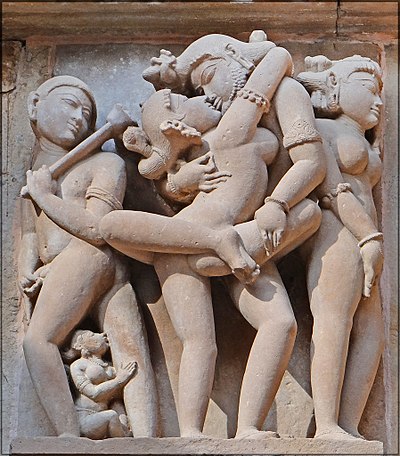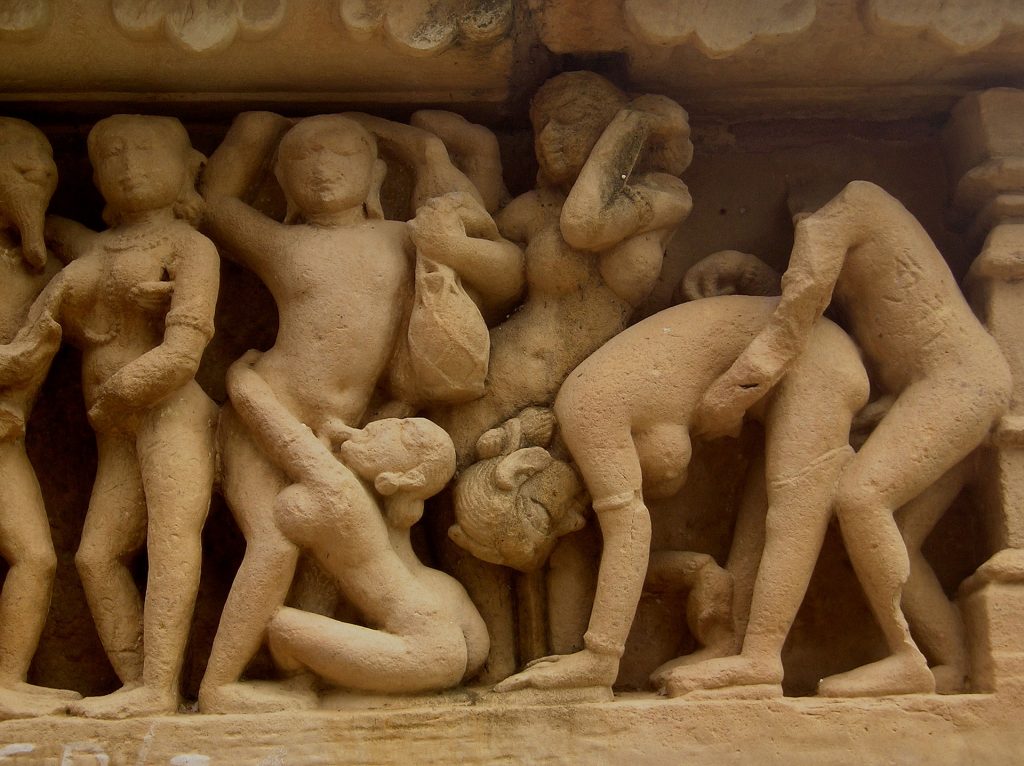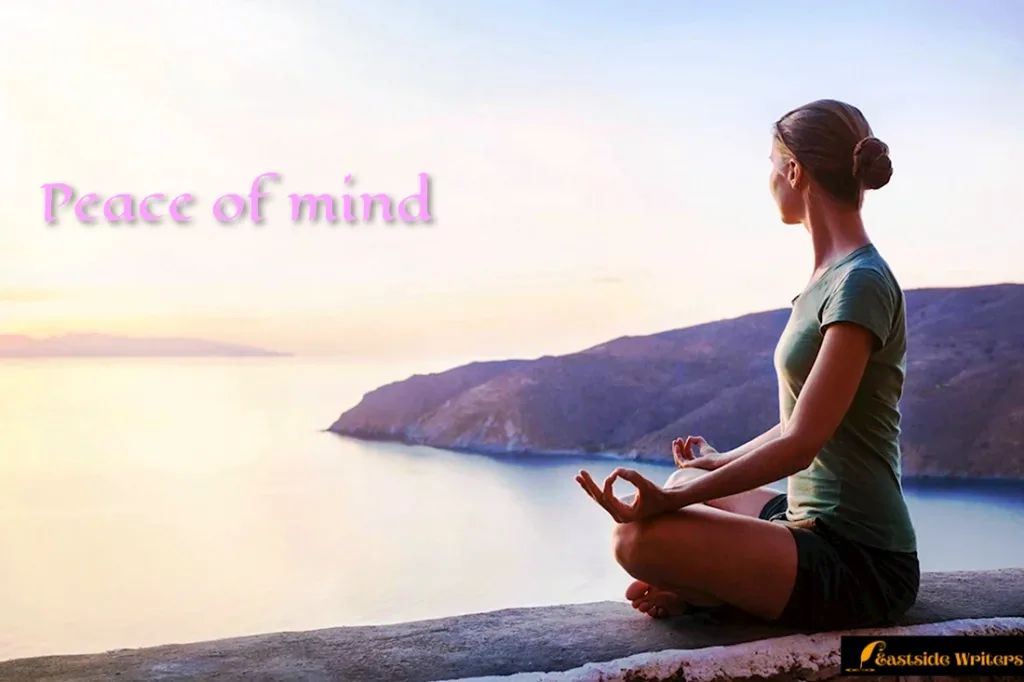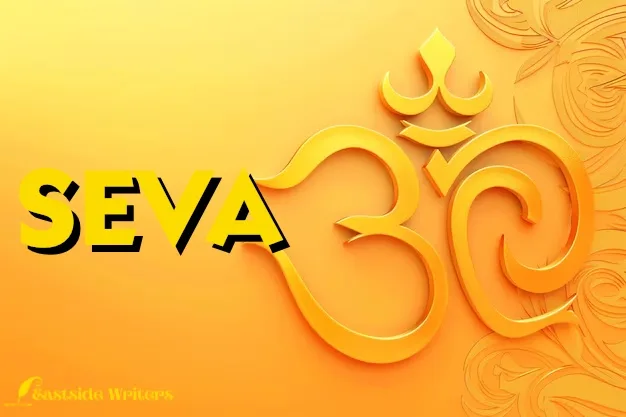The word “Kamasutra” comes from two different Sanskrit words. Sutra, which literally translates to “thread” and also means “instruction,” while Kama, means “desire, pleasure, love, or sex,” or is referred to as the name of the deity of sensual love. The combined name Kama Sutra means “Teachings on Desire.”

It continues to be a taboo topic since guardians and parents do not discuss it freely with their wards and offspring, and teachers in most countries are reluctant to bring it up in class. When it comes to healthy sex, which is extremely normal and a lovely gift without which you would not be able to come to this world, the subject itself has been looked down upon.
Without food and sex, you cannot survive and develop. Both represent opposite sides of the same coin. Without this amazing gift, you would not have been able to fertilise, reproduce, and bring children into the world.
What nature gave us
Growth is viewed by many as a process brought about by nature. It is undoubtedly organic and spontaneous. Through it, we want to enhance both our inner and exterior states, particularly how we engage with the outside world on a daily basis. With roots going down, shoots rising, and leaves appearing, nature supports the idea that growth is a normal, linear process. However, as adults, the development we want in our careers, relationships, actions, and even attitudes, can seem everything but linear.
The Kama Sutra describes love in a pure form a nature gift and designated as a multifaceted and intricate idea. Each act of love can be categorised into one of the following groups:
1) Love that endures while we are in a romantic relationship. In other words, this love grows out of habit.
2) Love is created in our minds. It relates to stroking, hugging, rubbing, kissing, and comes from a particular concept;
3) A long-lasting love between two people;
4) Love that develops as a result of our experiences. We show other people this love. It is love’s supreme manifestation.
Reproduction a necessity
Any species’ ability to reproduce is essential to its existence. Procreation is often sexual in nature and involves a mechanism that makes sure the male and female gametes come into contact at the right time. Sexual activity must take place when both the endometrium is receptive and the ovum is ready for spermatozoa to fertilise it. This is the only way for human reproduction to be successful. The fertile or bountiful window, which is a period of time throughout the menstrual cycle, is ill-defined and very individualistic.
Although spermatogenesis is a continuous process, it has been widely believed that too frequent intercourse, which is defined as happening more than every two to three days, has an adverse effect on conception or the fertilization process.
Present-day evidence issues formerly held beliefs about the fertile window and how it’s decided, when to have a sexual encounter and how it relates to getting pregnant and miscarriages, how long the luteal phase lasts, and exactly when in a menstrual cycle the chances of fertilisation are highest. Because spermatozoa can remain in the female vaginal tract for up to five days, fertilisation can take place up to five days after a sexual encounter. There is a window of 5 to 6 days during each menstrual cycle for fertilisation to take place. This window is determined by the timing of ovulation rather than the length of the cycle, with intercourse happening 1 to 2 days before ovulation.
In evolutionary psychology and behavioural ecology, mating refers to a collection of behaviours people use to find, choose, and keep partners. Reproductive strategies, which cover a wider range of behaviours concerning the scheduling of reproduction and the exchange between quantity and quality of progeny, overlap with mating strategies.
Although until very recently sexual activity was necessary for reproduction, this did not negate the value of romantic encounters and non-conceptive copulations in terms of non-reproductive matters. But thanks to technology, it is now possible to have intercourse without becoming pregnant and to get pregnant without penetration.

Human mating art- The Kamsutra
Human mating practices are distinct from those of other animals in how they interact with cultural elements like the institution of marriage. Humans may look for others with the goal of establishing a lifelong friendship, marriage, casual romance, or intimate partnership. One of the greatest human impulses is the need for connection. It may be connected to sexual desire and is a fundamental aspect of human nature. The social and cultural mechanisms through which two people may meet to determine their compatibility, the courtship phase, and the process of developing an interpersonal connection are all included in the human mating process. However, there are similarities between human and nonhuman animal mating behaviours.
The Kama Sutra’s most famous chapter, Chatus-Shasti (Sixty-Four), discusses 64 different sorts of sexual partnerships in great detail. Along with many forms of intercourse, it explains a range of kissing, biting, and scratching procedures. Additionally, it offers suggestions for their intensity.
Vatsyayana asserts that because of the intensity of the desire involved, sex is comparable to combat. The couples actually “leap” at one another as if they were fighting. They are particularly interested in the sides, tummy, and space between the breasts, back, shoulders, and head. These attacks are accompanied by whimpering, cooing, gasping, pouting, hissing, and erotic noises.
If a woman observes that her boyfriend is becoming exhausted from frequent coitus, she should place him on his back and switch roles with him. When she is in control, she determines the pace and length of sexual activity, exposing her genuine self. She also finds that switching roles satisfies her curiosity and desire for novelty. Additionally, the author offers doable advice on how to facilitate successful copulation.
Oral sex is only acceptable for masseurs and homosexuals, according to the Kama Sutra. In “normal” relationships, a man and a woman should only use their lips for foreplay activities such as licking, kissing, biting, or sucking other body parts.
In addition, Chatus-Shasti offers ideas for how to initiate and end sexual activity. For instance, it is not advised for lovers to look at each other after the act of love. Then, after taking separate trips to the bathroom, they should meet for a light supper and stimulating conversation.
There are several advantages to having sex.
It might enhance general well-being and foster good relationships. Additionally, it has been linked to individual advantages like less stress, better sleep, boosted immunity, and improved heart health. Humans feel and express their sexuality through human sexual activity, human sexual practice, or human sexual behaviour.
For a wide range of causes, people take part in a variety of sexual behaviours, from actions performed alone (such as masturbation) to behaviours performed with another person (such as sexual intercourse, non-penetrative sex, oral sex, etc.).
Sexual arousal and physiological changes are typically brought on by sexual activity in the stimulated person, some of which are more evident than others. Sexual activity can also involve behaviours and acts that are meant to pique another person’s interest in sex or to improve that person’s sexual life, such as wooing and displaying behaviours or intimate activities (like foreplay or BDSM) between people. Sexual arousal may be followed by sexual action.

Sexual Behaviour
Human sexual activity involves sociological, cognitive, emotional, behavioural, and biological components. These components include sex desire, sexual intercourse, and sexual behaviour in all of its manifestations.
Some cultures view marriage as the only setting in which sexual activity is appropriate, while premarital and extramarital sex are frowned upon. Some sexual behaviours are deemed against the norms of specific societies or cultures, while others are outlawed either globally or in specific nations or subnational jurisdictions. Sexual assault and engaging in sexual interaction with someone who is younger than the local consent age are two instances that are generally considered crimes in most jurisdictions.
Sex, emotional desires, and interpersonal relationships are prominent components of post-Vedic Sanskrit literature, including the Ramayana and the Mahabharata, two of the greatest Hindu epics. According to Johann Meyer, the traditional Indian perspective has been that love and sex are pleasurable requirements.
Despite being restrained and picky, “a woman stands in very great need of “surata” (sexual pleasure), and “the woman has a considerably stronger erotic propensity, her satisfaction in the sexual act is greater than a man’s.” Numerous creation hypotheses are present in Hinduism. Various Puranas present a variety of conceptions about conception and reproduction.
An Alternative Viewpoint
The Upanishads present an alternative viewpoint. Jnanis claims that our mind alone is the source of all creation. The Brahma Puranam provides an analogy for Adam and Eve if you’re looking for one. From his own body, Lord Brahma led to the birth of a man and a woman. The woman’s name was Shatarupa, and the man’s name was Svayambhuva Manu. Manu is the ancestor of all humans. The word “manava” is derived from “Manu.” In fact, scholars can assert that Manu is where the term “man” in English originates.
There are various tales of how Manu and Satarupa were created, and it is said in several other Puranas that they were the first humans. For instance, according to the Padma Purana, Manu and Satarupa were the first of many males and females to emerge from Lord Rudra’s Artanari swarupa (Half Female Form) when he divided the body in two at Lord Brahma’s request. The male half of the body gave birth to 11 males, and the other half produced females.
According to Michel Foucault, two processes have developed and disseminated “the truth of sex” across all human societies. One of the methods has been ars erotica texts, while the other has been the scientia sexualis literature which has been used. The first tends to be of the concealed sort and is often passed from one person to another, either between buddies or from a teacher to a pupil, focusing on the feelings and experience rather than the physiology.
The Realities of Sex
Many of the realities about sex and the nature of sexuality are buried by these. The second category includes empirical investigations that concentrate on physiology and unbiased observations devoid of feelings, similar to those found in biology, physiology, and medical texts. Both factions claim ownership of the Kamasutra. Citing and paraphrasing, it covers the physiology, emotions, and experience while referencing and paraphrasing earlier Sanskrit research on the meaning of kama.
An ancient Indian Sanskrit literature on sexuality, sensuality, and finding emotional pleasure in life is known as the Kama-Sutra, or “Principles of Love.” The Kama Sutra, attributed to Vtsyyana, was written as a manual on the art of living well, the nature of love, finding a life partner, maintaining one’s love life, and other topics relating to pleasure-oriented faculties of human life. It is neither exclusively nor primarily a sex manual on sex positions.
The book contains a passage that recognises the Purusharthas, a Hindu idea, defining one of the proper aims of life as achieving desire, sexual fulfilment, and emotional contentment. Its chapters cover a variety of subjects, including flirting, keeping power in a marriage, when and how to commit adultery, sexual orientation, and tactics for wooing. It also covers training in the arts to be socially engaged. The philosophy and theory of love, what causes desire, what keeps it going, and how and when it is good or evil, make up the majority of the book.

One of several Indian texts on Kama Shastra is the literature at hand.
It has been translated extensively into both Indian and non-Indian languages. In addition to the Indian arts, the Kamasutra has inspired other secondary works that appeared after the 4th century CE, as seen by the widespread use of Kama-related terms. Old Hindu temples often have reliefs and sculptures relating to Kama.
One of these is the UNESCO World Heritage Site Khajuraho in Madhya Pradesh. One of the remaining temples in north India depicts all the key sections and sexual positions from the Kamasutra in sculpture. This temple is located in Rajasthan.
The Kamasutra’s initial publication date or century is unclear. Its approximate dating ranges from 400 BCE to 300 CE. The Abhiras and Andhras kingdoms, which did not co-rule substantial portions of ancient India before that year, are mentioned in the Kama Sutra, indicating that it was altered or written after 225 CE.
At the start of the Gupta Empire, in the third century of the common era, most probably in its second half, the Kama Sutra was written.
Hindu temples frequently feature kama-related art. These scenarios could be a sexual position, a courtship, or loving couples sharing intimate moments (mithuna). The images above show temples from the sixth to the fourteenth centuries in Madhya Pradesh, Uttar Pradesh, Rajasthan, Odisha, Gujarat, Chhattisgarh, Karnataka, Tamil Nadu, and Nepal. Sculptures that are bare-chested or otherwise barely attired are incorrectly attributed to the Kama Sutra text, as though there are no other examples of displays of erotica in humans that are projected as nude sculptures in a euphoric way.
The Purusharthas are a notion from Hindu tradition that describe the “four primary aims of life.” According to this theory, everyone has four legitimate aims in life that are both essential and sufficient for happiness and fulfilment.
Dharma:
It refers to actions that are thought to be in line with rta, the order that gives life and the cosmos their ability to exist. It encompasses obligations, rights, rules, morality, and the proper way to live.
Hindu dharma encompasses one’s obligations in terms of religion, morality, and other personal virtues as well as actions that support social order. To maintain peace and order in the world, all living things must accept and uphold dharma. It is the pursuit and implementation of one’s genuine calling and nature thereby participating in the cosmic orchestra.
The word “artha” refers to the “means of life,” the activities and resources that allow one to live in the state they desire. Wealth, a career, a way to earn a livelihood, financial stability, and economic prosperity are all included in artha. In Hinduism, the appropriate pursuit of artha is seen as a significant life goal.
Kama:
It denotes affection or love, with or without sexual overtones. It also denotes want, emotions, passion, wishes, the pleasure of the senses, and the aesthetic enjoyment of life.
Gavin Flood defines krama as “love” that does not compromise one’s path to moksha, artha (financial success), or one’s moral obligations (spiritual liberation). Emancipation, liberation, or release are all referred to as moksha.

Moksha:
according to some Hindu schools, it refers to liberation from the cycle of rebirth and death in certain Hindu institutions, the concept of moksha refers to release from samsara, the cycle of rebirth and death; in other schools, it refers to liberation in this life as well as freedom, self-knowledge, and self-realization.
Hindu literature from the Vedic era has the earliest references to the Kamasutra. In verse 1.1.9 of the book, Vatsyayana acknowledges this ancestry by referring to Svetaketu Uddalaka as the “first human author of the Kamasutra.” Early Upanishadic rishi (scholar-poet, sage) Uddalaka’s thoughts can be found in the Brihadaranyaka Upanishad in sections 6.2 and 5.3 through 5.10, as well as the Chandogya Upanishad. These Hindu texts range in date from 900 BCE to 700 BCE.
These early Upanishads examine human life, occupations, and the meaning of existence as an internalised type of worship, where sexuality and sex are mapped into a form of religious yajna rite (sacrificial fire, Agni), and is infused with spiritual terms:
You see, Gautama, a lady is like a fire. When one penetrates her, those are her embers. Her firewood is the vulva, her smoke is the pubic hair, and her flame is the vagina. In certain Hindu schools, moksha denotes escape from the cycle of reincarnation and death known as samsara. In other schools, that concept is referred to as her embers, and her sparks are the culmination. The gods offer semen into that fire, and a man is born from that offering.
This is just one of many examples that show how the Kamasutra originated in the sacred literature of the Vedic period. Vatsyayana later refined and condensed these concepts into a text that belongs to the sutra genre.
The “earthy, colourful literature known as the Rigveda” of the Hindus is where this paradigm of praising pleasures, satisfaction, and sexuality as a dharmic deed first appeared. Hinduism’s religious environment includes the Kamasutra, which celebrates sex, sexuality, and pleasure.
The Kamasutra offers a wide range of alternatives and local customs for every facet of kama. The chapter, according to Shastri, as cited by Doniger, examines “the inclinations of men, good and bad,” and then gives Vatsyayana’s advice and justifications for what should be avoided as well as what should be experienced and enjoyed while “acting only on the good.” For instance, the book discusses infidelity while urging faithfulness in marriage.
The Kamasutra method does not minimise or dismiss the psychology or complexity of human behaviour for sex and pleasure. According to the book, a treatise “requires the inclusion of everything, good or bad,” but after being fully informed, one must “evaluate and accept only the good.”
Dating and flirting
A lot of issues are included in the text from the third century, including topics like flirtation that still have relevance in today’s world.
The Kamasutra advises, for instance, that the boy and the girl should play together by going swimming in a river. The boy should dive into the water far from the girl he is interested in, swim under the surface to get near to her, surprise her by coming up out of the water, and then make another dive away from her.
The majority of chapter 3 of the Kamasutra is devoted to the art of wooing with a view to marriage. The first line of the book declares that marriage fosters “a pure and natural love between the partners,” resulting in the pursuit of dharma (spiritual and ethical life) and artha in marriage, as well as more friends, family, offspring, and other emotional fulfilment in many other kinds (economic life).
The fourth chapter presents a similar topic for a woman and how she might acquire the man she desires. The first three chapters cover how a man can go about finding the perfect spouse. According to the text, a person needs to be reasonable and have the “same attributes that one wants from the partner.” It advises involving friends and family in the search and getting to know your future spouse’s present friends and family before getting married.
While astrology and numerology are not mentioned in the original text, the later commentary on the Kamasutra, like that of Yashodhara from the 13th century, mentions consulting and analysing the compatibility of horoscopes, omens, planetary alignments, and other indicators before putting up a marriage proposal. Vatsyayana says that one should “play, marry, socialise with one’s equals, individuals of one’s own circle” who have similar beliefs and ideals.
According to verse 3.1.20 of the Kamasutra, it is more difficult to maintain a good, happy relationship when there are fundamental differences between the two.

Foreplay and intimacy
Vatsyayana’s Kamasutra discusses numerous types of intimacy, including that which occurs between lovers prior to and during intercourse. For instance, lines 2.2.7 through 23 of the scripture explain eight variations of alingana (embrace). The first four show signs of shared love, that are nonsexual yet indicate a mutual love. The last four, however, suggest embracing types to boost pleasure during foreplay and intimate moments. The many forms of closeness reflect the intention and give ways to please multiple senses. Vatsyayana, for example, asserts that the lalatika form enables both parties to physically feel one another and helps the man to see “the complete beauty of the female body,”.
Sexual or Sensuous hugs
Sexual hugs intensify passion as well; these can also be used to make love, but only with caution. According to Kamasutra, the finest kiss for a close partner is one that is based on awareness of the avastha (the emotional state of one’s partner) while the two are not engaged in sexual activity. The text advises using abhiyoga and samprayoga to mirror during sex and to go with the flow.
Other foreplay strategies include holding and embracing (grahana, upaguhana), mutual massage and rubbing (mardana), pinching and biting, and using fingers and hands to stimulate (karikarakrida, nadi-kshobana, anguli-pravesha), three types of jihva-pravesha (french kissing), as well as numerous fellatio and cunnlingus styles, are all examples of the sexual intimacy described in the Kama
Adultery
The Kamasutra forbids adultery but then spends “at least fifteen sutras (1.5.6-20) enumerating the reasons (karana) for which a man is permitted to entice a married lady.” Vatsyayana covers the kama/sexual education, rights, and mores of several categories of nayikas (urban girls), including courtesans, widows seeking remarriage, married but abandoned by husbands, and unmarried virgins.
According to Vtsyyana, adolescence is the time for learning how to make a living; Youth is a period for enjoyment, and as time goes on, one should focus on leading a virtue-filled life in order to break free from the cycle of reincarnation.
The Kamasutra promotes adulterous sexual relations as a way for a man to set up the involved woman to support him, as a tactical way to work against his opponents, and as a way to make his triumphs easier. It also describes when a woman does not want to commit adultery as well as the indications and motivations for doing so.
The Kamasutra outlines methods for having extramarital affairs, but it finishes its chapter on sexual intercourse by advising against it because it only benefits one of the two parties to a marriage, harms the other, and violates both dharmas and artha.

Class, Caste And Creed
One of the few sources of information available on the sociology and cultural environment of ancient India is the Kamasutra. It exhibits a “near complete disdain of class (varna) and caste (jati)”. Human interactions, especially sexual ones, are not based on a person’s gender or caste and are instead connected to their wealth (or success in artha).
In the Kamasutra, lovers are described as being “not upper-class,” yet they “must be rich” enough to dress nicely, partake in social activities, purchase gifts, and surprise their partners. The one and only time caste are mentioned in the book is when a man is advised to tell amusing tales about “other virgins of the same jati (caste)” in order to entice a woman.
In general, the literature discusses gender-neutral sexual behaviour between men and women in both urban and rural contexts, regardless of status or caste.
Note: Excerpts and notes taken from “Mandala of Sex” by Dr Uday
Disclaimer: This information is for Knowledge and educational purposes only.
The author’s views are his or her own. The facts and opinions in the article have been taken from various articles and commentaries available in the online media and Eastside Writers does not take any responsibility or obligation for them.
Note: Contact our Writers at www.eastsidewriters.com for writing Blogs/Articles on any niche. We have experts in various domains from Technology to Finance and from Spirituality to Lifestyle and Entertainment.







Pingback: Men Look For Sensuous Beauty In Women Of 2023 - Eastside Writers
Great Article! Wow nice information yes you are right “human never develop without food and sex” great thought 💭
Pingback: Secret Benefit Of The Lipstick That You Wear In 2023 - Eastside Writers
Pingback: The Infamous Tantra Traditions and Sexual Practices - Eastside Writers
Pingback: Hypoactive Sexual Desire Disorder - Its Cause and Remedy
Pingback: Is The Foul Smell In Your Penis A Matter Of Concern - Eastside Writers
Pingback: Amazing Benefits Of Drumsticks Form Treating Respiratory Illness To Lowering Blood Sugar - Eastside Writers
Pingback: Multiple Benefits Of Safed Musli In Maintaining Health & Boosting Energy
Pingback: Never Ignore Penis Sores And Blisters As It Can Be Fatal - Eastside Writers
Pingback: 12 Tips To Trigger The Flow Of Happiness Hormones In Your Body - Eastside Writers
Pingback: 10 Natural Home remedies that help during menopause can be a great Relief - Eastside Writers
Pingback: Debunking 7 Common Penis Myths: Separating Fact from Fiction - Eastside Writers
Pingback: The Art of Letting It Grow: Surprising Benefits of Not Shaving - Eastside Writers
Pingback: Navigating the Unspoken: Understanding the Severity of Urinary Incontinence in Men - Eastside Writers
Pingback: The Ultimate Guide to a Flat Stomach: Secrets Men Need to Know - Eastside Writers